The Weird Story Behind Weird Wheels!
By Kurt Kuersteiner © 2010 Monsterwax
Monster Trading Cards
Since 1969, Donruss had pretty much cornered the non-sports market in hot-rod cartoon stickers. Odd Rods (3 different series), Fiends and Machines, and even Silly Cycles set the standard for what "gear head" collectors expected in colorful art cards. If that weren't enough, Donruss also issued a "best of" series of Odd Rod All Stars in 1971, and in 1973, two more reissues of Odd Rods, plus an original series of Fantastic Odd Rods. Those stickers popped up everywhere, even in small Southern towns (where I first encountered them). They were so prolific that if they could have fueled cars, we would have easily avoided the Arab Oil Embargo that same year. But for freaky hot rod card collectors, a nagging question remained unanswered: Where was Topps during this feeding frenzy? And why hadn't they released a competing series?
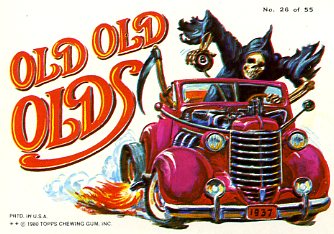
#26 Weird Wheels. The same character was used on the wrapper.
Fast forward to 1980, and Topps finally answered the challenge by issuing their own set of fast and furious freak cars. The new sticker series was called Weird Wheels, and it certainly rose to the occasion. Unfortunately, the Big Daddy Roth fad had faded by then, and far more product was made than could be sold. (It is still cheap today as a result.)
It has been commonly reported that this series was the last card set Norm Saunders painted for Topps, with other art contributed by an unknown second artist. While it is certain that Saunders worked on the set, there are conflicting memories as to whether Saunders painted any of the images himself from approved designs, or if he just retouched the otherwise finished paintings from the other artist. Topps would routinely hire Saunders to paint cards for sets, but for added speed, they would also hire other painters to contribute cards as well. Then they would pay Norm extra to apply a final polish (or "master's touch") to the other artwork so that all the cards in the set had a similar (and overall higher) quality. He did this, for example, with Civil War News, Battle, and Mars Attacks.
Separating who did the majority of any single painting has always been tough, but David Saunders, Norm's youngest son (and an artist himself), has had a lot of practice with it. He believes his father painted twenty-two of the Weird Wheels images: #1, 5, 7, 9, 10, 11, 13, 14, 17, 18, 19, 20, 22, 23, 25, 26, 27, 28, 29, 30, 31, and 33. He doesn't think Norm only touched up the 55 images in the set. What he remembers is his dad beginning several paintings from approved designs. David was about 25 at the time, and Norm was in declining health from emphysema. When he caught his 73-year-old father working on Weird Wheels, he told him to stop since it could kill him! Norm's response was classic: "It's fun! I gotta keep working. What the hell else am I gonna do?" Needless to say, he didn't stop. (After all, father knows best.)
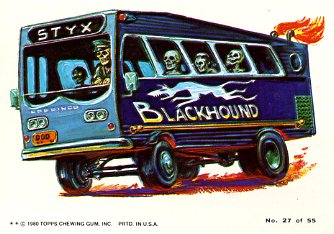
#27 Weird Wheels
So who was the unknown second artist? And did that person paint most of 33 images, or all 55? I can't answer the second question, but I can answer the first. Thanks to the power of Google and some oblique references found buried on the web, I was able to identify the missing artist and contact him. His name is Gary Hallgren, and he's been a full time artist for over four decades. His story is very interesting, combining luck, fate, and history, all into one narrative.
Hallgren studied painting and design at Western Washington State College in 1969. He moved to San Francisco in 1971 to team up with other artists (including Dan O'Neill) to publish two issues of Air Pirates Funnies . The underground comic became controversial because it contained savage parodies of Disney cartoons like Mickey Mouse. Sure enough, Uncle Walt's lawyers came calling, and a highly publicized lawsuit resulted. It was eventually resolved, but that experience led Hallgren to job opportunities freelancing with other parody publications, including Mad and National Lampoon magazine.
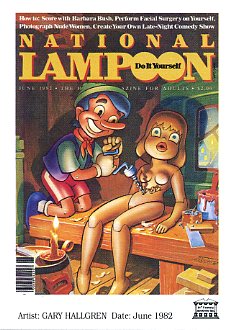

National Lampoon covers by Hallgren
Hallgren enjoyed working with National Lampoon throughout the mid 1970s and 80s, contributing cartoons and covers. Perhaps his most famous Lampoon gag was the award winning "Do-it-yourself-Pinocchio" cover. (It was later reprinted as card #80 in the National Lampoon card series.) His cartoons still appear in Mad Magazine.
While in San Francisco, Hallgren met and worked with other counter-culture artists on El Perfecto, a comic published to raise money for Timothy Leary's defense fund. Dr. Leary's public endorsement of drugs made him "the most dangerous man in America," according to then President Nixon. (This was, after all, in the far out 70s, man!) Leary had been sent to prison on a drug charge, escaped, fled the US, was rearrested, extradited, and faced a newer, tougher sentence. The funds raised by El Perfecto failed to get Leary off the hook, but he was released early in 1976 by the new governor of California, Jerry Brown.
What the comic did achieve, however, was it made important contacts for Hallgren. One was Art Spiegelman, who returned to New York to work for Topps. By 1980, Hallgren also moved there and needed work. Topps was looking for an artist with experience painting hot rod cartoons for a new series. Spiegelman remembered Hallgren was a gear head (car fanatic), so he recommended Hallgren for the job. Topps had about ten funny names cooked up. Hallgren agreed to do the work "for hire." This meant no signatures on the paintings, no royalties, and not much money either. But there were two rather unusual concessions (at least, compared to how Topps usually operated back then): They agreed to return Hallgren his artwork when the set was printed, and he could dream up the remaining 45 or so images on his own (with Topps retaining final approval). He estimates he devised about 80% of the finished titles and concepts.
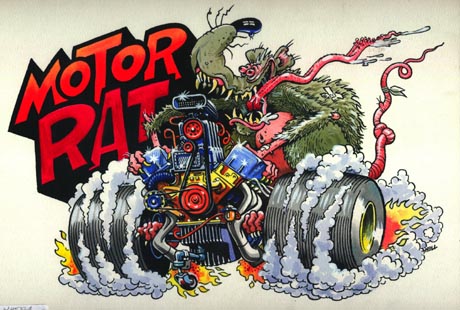
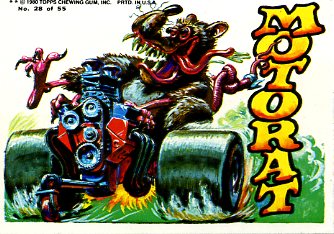
Above (L) The original submittted to Topps by Hallgren to get the job, and the revised # 28 (R) from the set.
It is no secret that most of what Topps makes is created by committee and farmed out to freelance artists, who have very little say in the matter. Topps usually kept the artwork for themselves, or gave it to VIPs, or worse yet, sold it at auction like they did in 1989 and kept all the profits. (They're still doing it today through Topps Vault on eBay.) But Hallgren got all his artwork back and still has it to this day. (Since you're probably wondering, no, he's not looking to sell them yet.) He also kept his additional artwork for the sequel series to Weird Wheels which he painted before it was officially cancelled by Topps (see sample). Naturally, Topps still had final say on the first series, and one editorial decision they made was to have all the paintings retouched by Saunders to make them look less underground or "edgy", and a little more mainstream.
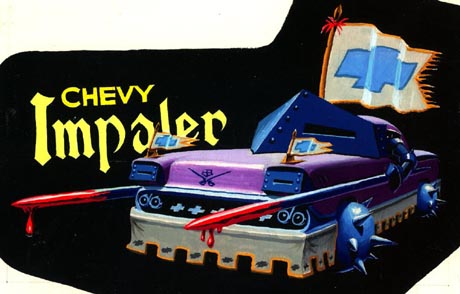
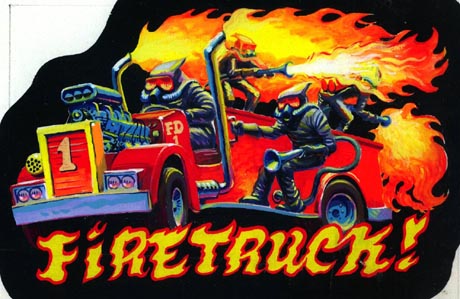
Two of the cancelled sequel series to Weird Wheels by Hallgren, not publicly seen until now.
According to Hallgren, his own artwork was not yet at its peak. Even so, he didn't like having his paintings modified by someone else. But as a commercial artist, he knew to expect such things "for hire". Luckily, Saunders really knew his stuff, adding highlights to make the images pop out more, redoing the flames, and toning down some of the peeling rubber (since parents don't want their kids speeding). Hallgren says Saunders also added some of the various monsters and ghouls in the machines.
One of Topps' requirements for that series was a "no outline policy". This meant there was to be no black outline around the images. If you compare the Odd Rods series from Donruss to the Topps Weird Wheels series, you'll see how the missing outlines make the Topps cards seem more like paintings and less like colored illustrations. It's a subtle touch few notice until it's pointed out, and then it is hard to ignore.
Hallgren worked on other series for Topps as well, painting some Wacky Packages, and a handful of Garbage Pail Kids . (He also illustrated their colorful sticker book.) But he never had as much creative influence on the outcome of the overall product as he did with Weird Wheels.
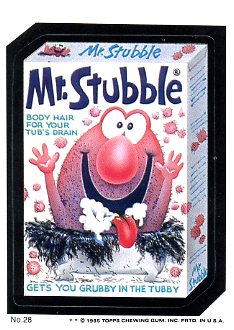
One of Hallgren's Wacky Packages (1985)
Today, he continues to paint, cartoon, and illustrate a variety of different topics, almost all with a strong humor theme. Mainstream comics wise, he painted the covers and illustrated a four book mini series for Marvel called Mort, the Dead Teenager. His panel cartoons have "stained" (as he describes it) the pages of many nationally recognized newspapers, including The New York Times, The Boston Globe, The Washington Post, and The Wall Street Journal. They've also popped up in places as varied as Nickelodeon for kids, to the adult magazines like Hustler and Screw. His latest efforts involve humorous medical illustrations in a series of books by Dr. Roizen & Oz.
Hallgren remembers meeting Norm Saunders. He didn't know how famous Saunders was back then, in part, because he didn't act it. Norm was "just a nice elderly white-haired gentleman with Len Brown". (He learned of Saunders' legendary career much later.) He also remembers meeting Big Daddy Roth (of Hot Rod and Rat Fink fame), back in his West Coast days. Hallgren now resides in Massachusetts, where he loves to collect --no, not cards-- but cars (Studebakers).
So there you have it. Two different memories about one really cool sticker series. After thirty years and countless commercial art projects, it's not surprising that one or both eyewitness(es) remember things differently. If Norm were still alive, we'd probably have a third version of events as well!
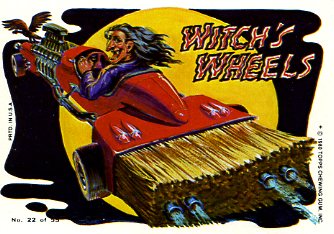
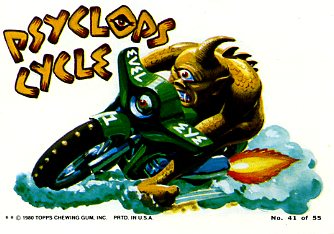
However, one thing is beyond debate: Card collectors owe both artists a big debt of thanks for this really cool series. Weird Wheels is the perfect set for collectors who like Odd Rods , or even monster type art. After all, werewolves, demons, witches, snake men, vampires, ghouls, skeletons, and Frankenstein monsters abound. The titles are pretty clever, too ( Voo-Doo Vette, Slab Cab, Putrid Porsche, and Psyclops Cycle, to name but a few.) It's still one of the cheapest hot rod series as well, with a complete NMT set selling for around $10. If you don't already have 'em, I suggest you jump in your rod, rev up the engine, and peel out to your nearest dealer!